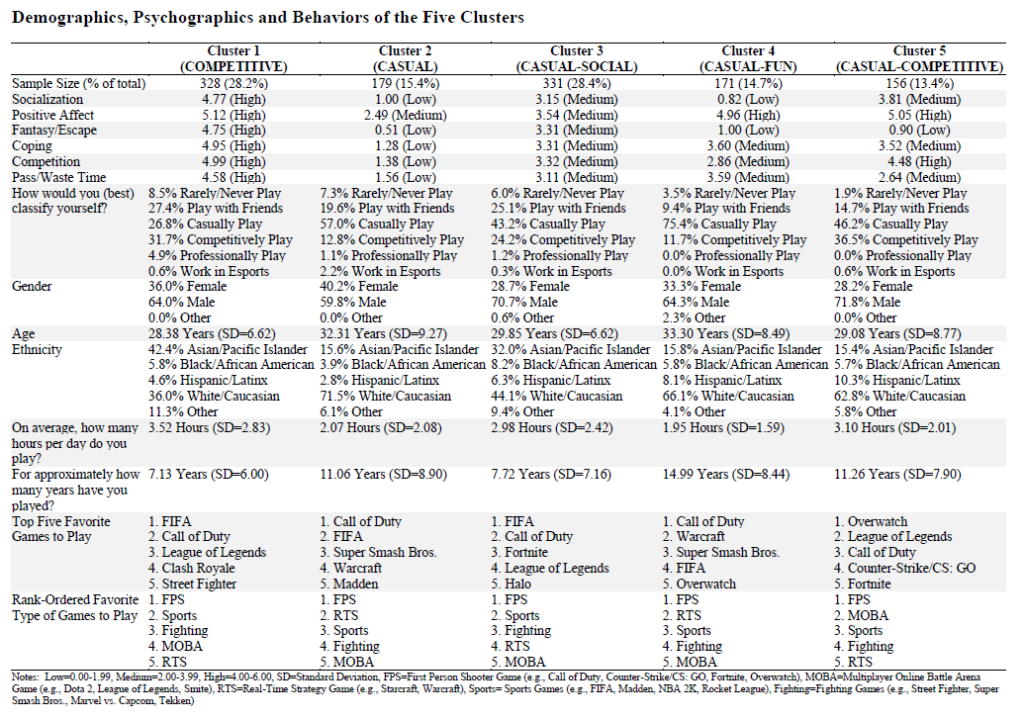By David Hedlund, Chairperson of the Division of Sport Management and Associate Professor at St. John’s University in the US.
Today, there are several well-known classifications of esports players. Newzoo (Bosman, 2020) has “Nine Personas” of gamers (Ultimate Gamers, All-Around Enthusiasts, Conventional Players, Subscribers, Lapsed Gamers, Backseat Viewers, Popcorn Gamers, Hardware Enthusiasts, and Time Fillers). Niko Partners (2019) identified seven classifications (Story Socializers, Casual Challengers, Skill Masters, Strategists, Arena Gamers, Fantasy Arena Gamers, and Competitive Arena Gamers). Quantic Foundry and Yee (2020) have noted nine unique player segments (Acrobats, Gardeners, Slayers, Skirmishers, Gladiators, Ninjas, Bounty Hunters, Architects, and Bards).
In February of 2021, the Journal of Global Sport Management published my new typology of esports players. Based on the same types of statistical methods and parallel types of data collected and used by market research firms, this journal article, in combination with my previously published research (see Hedlund, 2019) attempts to provide validation (or not) to much of the work that has been previously done by market research firms.
Hedlund, D. P. (2021): A typology of esport players. Journal of Global Sport Management. doi: https://doi.org/10.1080/24704067.2021.1871858.
In Hedlund (2019), I demonstrated how I reached the conclusion there were six important multidimensional constructs needed to reliably and validly measure the motivations of esports players. The six constructs I identified and their respective explanations are:
- Socialization – Esports provide an opportunity to communicate, create relationships and connections, and feel a sense of community with others
- Positive Affect – Esports are a fun way to pass the time, feel enjoyment and relax
- Fantasy/Escape – Esports provide an opportunity to become someone else, pretend to be a different person, and pretend to have a different identity
- Coping – Esports provide an opportunity to release pressure in life, cope with anxiety, and cope with stress
- Competition – Esports provide an opportunity to develop the skills involved in playing the game, measuring those developed skills against others’, and winning
- Passing/Wasting Time – Esports are a cheap way to pass the time, provide an opportunity to do something when there is nothing else to do, and just waste time
Then in Hedlund (2021), using those six multidimensional constructs as the basis of the analysis, I utilized hierarchical and k-clustering techniques to identify esports player segments in the data. As a result of these techniques, I labelled the five groups of players (i.e., clusters) as follows:
- Competitive
- Casual-Competitive
- Casual-Social
- Casual-Fun
- Casual
The table below, shows information about each of the five groups of esports players.

The result of this research is an initial typology of five types of esports players, based on their respective motivational levels of a desire for socialization, positive affect, fantasy/escape, coping, competition, and passing/wasting time. Of course, there are alternative ways to segment or cluster the data, based on characteristics such as how do players self-classify their own motivations to play esports, how many hours a day they play, for how many years have they played esports, and what types of esports games/genres they play.
Esports and gaming present many unique opportunities to different types of people. There is no single type of popular game, nor is the one type of person that plays esports. Everyone and anyone can play esports, and there are multitudes of game titles and genres for people with every interest. The job of researchers is to analyze people and attempt to understand motivations and meanings behind what they do. Hopefully gaming and esports researchers, in partnership and with consideration of market research groups, will continue to undertake this important and never-ending research on understanding what we do and why.
References:
Bosman, S. (2020). The way consumers interact with games is changing; Nearly half of gamers are female; over half are 30+. Retrieved from https://newzoo.com/insights/articles/consumer-engagement-with-games-is-changing-gamer-segmentation-personas-gender-age-demographics/.
Hedlund, D. P. (2019). The motivations of esports players. In R. Rogers (Ed.), Understanding esports: An introduction to the global phenomenon (pp. 95-114). Lanham, MD: Lexington Books.
Hedlund, D. P. (2021): A typology of esport players. Journal of Global Sport Management. doi: https://doi.org/10.1080/24704067.2021.1871858.
Yee, N. (2020). Player segments based on gaming motivations. Retrieved from https://quanticfoundry.com/2020/08/17/player-segments/.
Niko Partners. (2019). Greater Southeast Asia gamer segmentation study. Retrieved from https://nikopartners.com/greater-southeast-asia-gamer-segmentation-study/.

